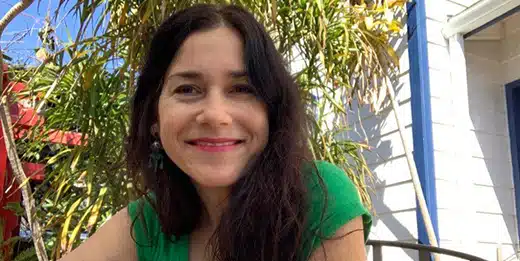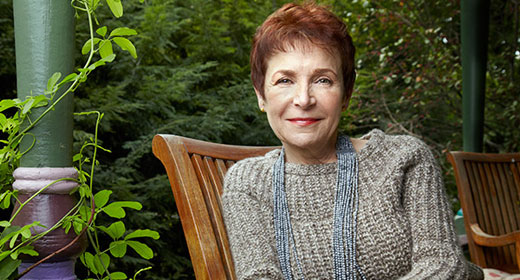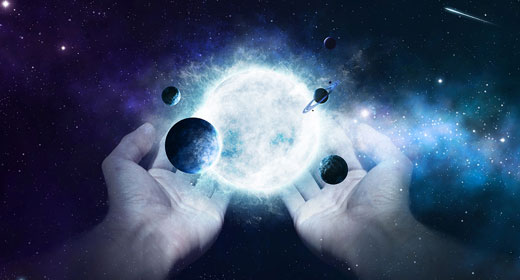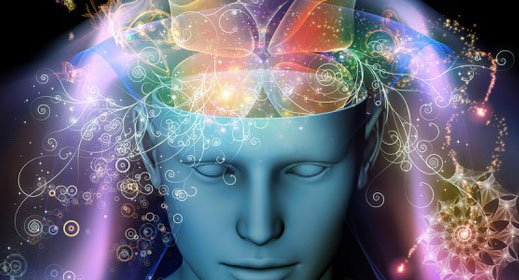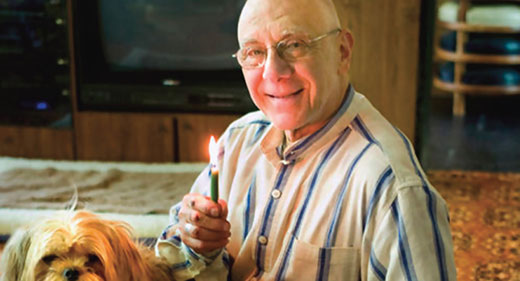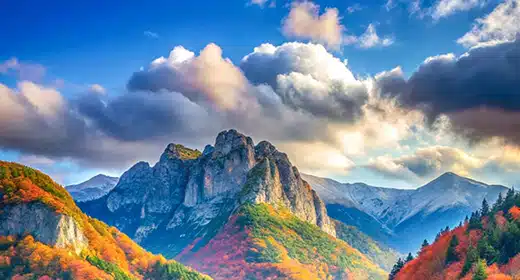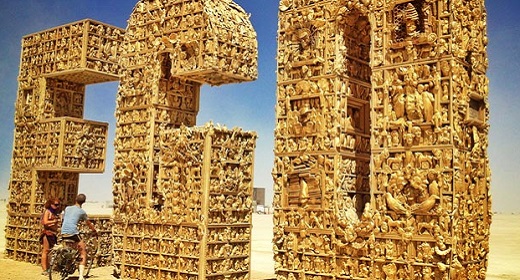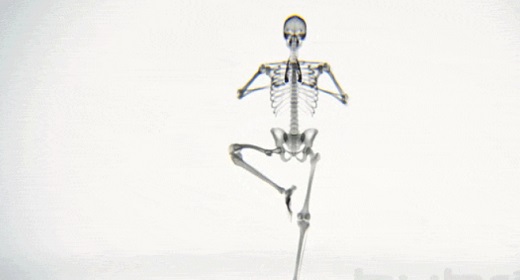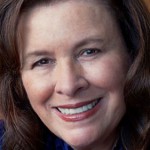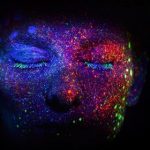Insights from The Edge interview with Anodea Judith.
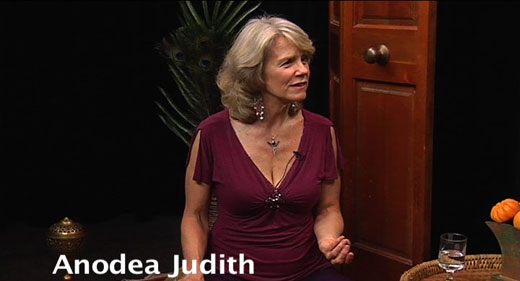
Tami Simon: You’re listening to “Insights at the Edge.” Today my guest is Anodea Judith. Anodea is an internationally acclaimed speaker and workshop leader, a yoga teacher, psychotherapist, and author. She holds a doctorate in mind-body health and a master’s in clinical psychology. She is the author of such chakra classics as Wheels of Life and Eastern Body, Western Mind, and the award-winning book Waking the Global Heart.
Anodea has worked with Sounds True to create an audio learning series on the chakra system called The Chakra System: A Complete Course in Self-Diagnosis and Healing, and also an integrated learning kit called Chakra Balancing: A Guide to Healing and Awakening Your Energy Body.
In this episode of “Insights at the Edge,” Anodea and I spoke about the complex architecture of the chakra system, the chakras in terms of the individual and collective, and the evolutionary progression of the chakra system. Anodea also went into detail about early childhood development and the chakras, as well as the central importance of undoing the knot at the level of the heart. Here’s my conversation with Anodea Judith.
Anodea, I have an inner nickname name for you! I refer to you as the chakra lady, and I think that I think of you as the chakra lady because you’ve introduced chakras to so many people. And I’d love here, at the beginning of our conversation, for you to really help us, in a feeling way, to understand what the chakras are. I hear people refer to them a lot, it’s part of our everyday dialogue—“Oh, that’s a this chakra issue” and “Oh, those are spinning disks that process information”—but yet I think a lot of people don’t really understand what the chakras are, and how they work. And you’re the chakra lady, so I know you can help us!
Anodea Judith: Sometimes people call me the chakra chick!
TS: There you go!
AJ: Yes, I would love to, because I think that as the chakras have become so popularized, there is a bit of a trivialization that has occurred, which kind of happens when things hit the West and become popular.
So to me, the chakras are a deep, profound system of holistic integration and spiritual evolution. They are a pattern, a map if you will, for the navigation of the journey to consciousness, both for individuals and for the culture at large. They show how heaven and earth are connected within what I call the architecture of the soul. So they’re really a path to the divine, and a path to the deep self within.
TS: Now, you’re said a lot just in those introductory comments. Explain what you mean by the “architecture of the soul.”
AJ: Well, if you were to study bodywork, for example, you would take a course in anatomy and physiology, and you’d study the spine and the bones as the architecture of the body. And as therapists, we study different models for the architecture of the soul. And this is an Eastern model that really applies beautifully to the West, which is how the soul and the energy of the evolution of that soul, and its journey and its lessons and its struggle, is really arranged within the psyche. So it’s our interior architecture that we would do well to understand as a way to understand ourselves and our journey.
TS: OK now, you also made an interesting point, that the chakras are both personal—we have individual chakras—but a collective sense of what the chakras are. What did you mean by that?
AJ: Well, as I have looked at this map for almost 40 years now, I’ve looked at it from all different sides, and I can see that historically, humanity has grown through the chakras. And I believe that we are now moving from third chakra to fourth chakra in this great consciousness revolution and this great social shift that’s going on on the planet right now. But that we progress—we were cave dwellers living on the land, and then we were procreating and making our first communities, and then we came into empire and we had the power over rulership to organize society together. And now we’re going to a new organizing principle based on the heart, and this is the shift we’re in now. So culturally you can see these patterns as well.
TS: So it sounds to me that when you talk about the progression of the chakras, that this is a pattern you apply to many different things.
AJ: Yes, many different things. It’s kind of like a cosmic map that maps onto many dimensions. And what I mean by that is the physical dimension, in that the chakras have a location in the body. We say the heart chakra is in the chest, and the throat chakra is in the neck. Or physiologically, it corresponds to nerves, nerve ganglia, or glands in the endocrine system, our physiological systems. You could say it corresponds to the emotional body; you could call that another dimension, if you will. The imaginal body, the visual realm. And many different people have postulated different planes, like the causal plane and the Buddhic plane and the astral plane. The chakras actually apply to all of these simultaneously, and bring them into a system of wholeness.
TS: OK, now, I still want to get even more concrete, if you will. I mean, we’re talking about something, the chakras, that live in our energy body. And most people can’t see the chakras—
AJ: No, they can’t.
TS: So we’re talking about something that can’t be seen. Now, can you see the chakras?
AJ: I can if I choose to look with those eyes. So it’s sort of like if I said to you, “Do you know how to read English?” And you’d say, “Yes, of course.” And if I held up a newspaper from across the room and I said, “Tell me what it says,” you could probably only tell me the headlines; you actually have to sit down and read it.
So if I actually sit down with a concentrated focus to read someone’s chakras, I can see them. But unless I do that, it’s not like they’re in neon shining out when I’m not thinking about it.
TS: OK, so let’s say you sat down, and your objective was to read the fine print in the newspaper—
AJ: Yes, exactly.
TS: —to see somebody’s chakras, what would you see? Tell me what you see when you go through that exercise.
AJ: Well, what I see—and of course I’m trained in doing this process—is I see in my mind’s eye a visual metaphor for what that person’s energy is doing. So I kind of reach forward with my hands as a way to tune in to that person’s energy field, and that tuning then comes through my system. And the way I get information is I see a visual form, sort of like a dream.
So I might say to somebody, “Gee, you’ve got a Mack Truck in your third chakra!” It doesn’t mean they actually have a truck in their third chakra, of course, but that’s a metaphor for for how they may be driving their power center. You know, like big and bluntly and powerfully, just running over everything. Or I could say, “You have a football player in your third chakra” or “You have a mouse in your fifth chakra,” meaning you have a little mousy voice.
So I actually see it as a metaphor, and I allow those metaphors to appear in my mind’s eye as a way of translating what I feel energetically back to the person in the way that makes sense to them.
TS: OK, so I think I’m following you. You sort of see a dream sequence or a visual sequence or an imagistic sequence as you tune in to each of the chakra centers. But yet most of the ways that the chakras are visually depicted are as some kind of web of inner-connected petals opening. Do you see that when you look at a person?
AJ: No, I don’t. Those are really stylized metaphors as well. They’re symbolic of the chakras. So it’s not like I would look at a third chakra and see 10 literal petals, and look at the throat chakra and see 16 petals. And that’s how the ancient diagrams draw them. So it’s not that I would see that.
And I do sometimes see colors. But more what I can see visually is how the body shapes itself around the chakras. So I could see a collapsed chest, or a constricted throat, or sometimes what I call a bully belly, an extended, excessive third chakra. I can see that physically in the body. And one needs no kind of clairvoyant sight to be able to see that; they just need to understand the chakra system and how it plays out in the body.
TS: OK, so these classic diagrams, the diagrams say that there are X number of petals—how are we to understand them? Are those metaphoric? Is that the best way to understand them?
AJ: Yes. They’re metaphoric; they’re symbolic, really. So the four petals of the first chakra to me symbolize the four directions of the earth. So wherever you stand, you can orient yourself north, south, east, and west. Those are like the petals that come out from the chakra.
For instance, in the third chakra, it’s 10 petals. I think of that as the 10 fingers, because our hands extend out, and that’s how we do things, that’s how we manipulate the world. In fact, “manipulate” comes from the word “man,” which means “hand.” So there’s a symbolic representation. The throat chakra has 16 petals, and there are 16 vowels in the Sanskrit alphabet. So that represents the sounding of the vowel sounds that we can intone.
So there’s many people that try to figure out: What does this pattern mean? What does the number of petals mean? Nobody really knows for sure. What we do know is that they represent the fact that the chakras become more complex as you rise from first chakra to the seventh chakra. And so dealing with six of something is more complex than dealing with four, and dealing with 12 of something is more complex than dealing with six. So that the chakras are actually spinning at a higher frequency; they’re more inclusive, they’re more expansive, they’re more complex as you go up.
TS: Umm-hmm. Now, once again I’m going to continue here on my quest to make this energy-body phenomenon as concrete as possible, so I hope you’ll bear with me.
AJ: Oh, that’s great with me!
TS: OK. Because here we have images, classical drawings, that are a metaphor, and your way of seeing the chakras in another person is also to receive sort of specific metaphors, that are specific to that person and their current condition. So what can we say that many people will agree on? What can we say for certain about what the chakras actually are, what they universally are?
AJ: Well, literally the word means “wheel” or “disk.” So we can feel them as a vortex of energy within the body. And sometimes if someone is sensitive with their hands, they can feel it around the body.
But a simple example that anybody can relate to is getting up in front of a crowd of people and feeling butterflies in your stomach because you’re nervous. Or kind of a frog in your throat, or falling in love and finding your heart just wants to fly. These are very common experiences that we can’t see visually, but that we can all relate to, that we’ve felt that. Or standing on the edge of a cliff or on a high building, and feeling your legs shake because you don’t feel safe in your ground.
So these are energetic experiences that are common. And they’re the activities of the chakras. They’re an example of it.
TS: OK. And you talked about understanding this architecture of the chakras moving up the body as a type of evolutionary pathway. Can you explain that, the evolutionary nature?
AJ: Yes. Each of the chakras represents a state of consciousness, or a level of understanding, in a way a lens through which we see the world.
The first chakra, for example, is our instinctual consciousness that is oriented to survival. So that’s just your fight or flight; there’s not a lot of mental reasoning in it, people just react. The emotional consciousness is second chakra. That’s a little bit above the instinctual, but still we know people’s emotions can be pretty raw, they can be pretty reactive, they don’t always have a lot of consciousness in it. And then as we come up to the next one, the power chakra; there’s a little more consciousness in it, there’s a little more understanding, there’s a little more reasoning. So that as we evolve upward, we go to more expansive and more inclusive levels of understanding, and lenses through which we see the world.
For instance, if someone sees their whole world as a chance to advance their power, they’re just coming from the power chakra. They may not get up to the heart chakra, and they may not have very good relationships, because they see people only as instruments of their power. So we evolve up through the chakras to higher—and more expansive and inclusive, complex and mature, actually—states of consciousness.
TS: And it seems that in your work, you actually look at working with the chakras as a type of spiritual path, that you could say, “My spiritual path is that I do chakra work.” Does that make sense to you, that’s that’s what somebody could actually say?
AJ: Oh, absolutely! Absolutely. You know, Carl Jung said, “Everyone in their life needs an archetype of wholeness.” For some, it might be the Tao; for me, it’s the chakra system. It is an archetype for wholeness. So that has been my spiritual path, connecting heaven and earth, climbing up the column of the chakras, to increasingly more evolved states of consciousness. Of course, I’m still evolving!
TS: Yes. And if somebody said, “I’m curious about chakra work as a path,” what does that look like as a spiritual path?
AJ: Well, what that looks like is having this map, or this template, and holding it as a guide to sort of compare yourself with. Not that everyone has to be alike, but we look at the elements of the chakras, for example—earth, water, air, fire, sound, light, and thought—and someone might say, “Well, I’m a little too fiery, I don’t have enough water” or “I’m a little too watery, I don’t have enough fire.” And they can use this as a formula for their own wholeness. They know what they need more of, what they need less of, to come into balance.
And as they do the work of clearing the blockages that get lodged within the chakras—and these blockages are largely defensive mechanisms. As they clear these defense mechanisms, they have more life force of energy available to them, and less in the way of their consciousness. And they can perceive more directly, they can function more effectively, their health is better, they have more sense of aliveness, and more sense of wholeness.
TS: Umm-hmm. Now, you said something very interesting, that the blockages in the chakras are defense mechanisms. And I know that you’re a trained psychotherapist, and that you work a lot with the psychology of the chakras. So what does that mean, that the defenses are what create blockages within each chakra?
AJ: Well, the chakras, as I see them, are gateways into and out of the core. The core runs at the very center of the being, from heaven to earth and from earth to heaven. And the core is what we all have in common. To me, the core is God and Goddess, the Divine, whatever word you want to use. And it’s so precious there that as children, we want to protect it. And so if what’s in our environment as children is toxic, then we will filter it out in order to protect the core. And we’ll do that through the chakras, through the gates in and out of the core.
So if it’s toxic physically, like a child is getting hit in some way, or it’s a dangerous environment, they will create defenses in their first chakra. If it’s toxic emotionally and there’s things they don’t want to feel, then they will create defenses in their second chakra. If there’s abuse of power, for example, then they might create defenses in their third chakra. If they don’t get enough love, or the love they have is kind of twisted, as it is in some families, then they might create blockage or defenses in their heart chakra.
So the defenses are largely to keep the outside from coming in, but also to keep the inside from coming out. For instance, if a child is told, “Oh, we don’t want to hear what you have to say! Go to your room and shut up,” then that child goes, “Oh, what’s in my throat chakra?” I mean, they don’t say this consciously, of course, but they kind of constrict that and say, “Nobody wants to hear what’s inside here” or “Nobody believes me when I talk,” so they’ll shut that down as a way of not letting the inside come out.
So the defenses mediate between the inner world and outer world. And as we get more defended, then things from the outside don’t really come in and touch us, and things that are really core to the authentic self don’t really come out.
TS: Now, let’s say that I want to do a self-assessment with my chakras. I want to look inside, and I want to see where I might be the most blocked, where there might be these defenses. What would you suggest? How could you advise me on this process?
AJ: Well, the simplest way to say that would be to look at yourself in terms of the elements of the chakras. So with earth, which is first chakra element, you could look at your body. A body that makes too much earth would be a heavy body, and a body that makes too little earth would be very thin and light and have trouble gaining weight and trouble being grounded. So you could take the elements—earth, water, fire, air, sound, light, and thought, or consciousness—and you could look at your life on each one of those levels and say, “Do I do too much of that, or do I do too little of that? Do I need to expand and develop more here, or am I so stuck in this that I’m always going there, and I need to do less of it so I can go somewhere else?”
And so you could use the elements as kind of a template to, if you will, measure yourself, and find out from there where you need to work. And that’s just one method.
TS: Now, that method seems like something where I’m using my analytical mind and I’m looking at my life. What about the idea of actually putting my attention into the physical part of my body where that chakra is, and investigating somehow that way?
AJ: Oh, yes, absolutely. And certainly any kind of symptoms that one comes up with can be related to the chakras. And so many people want that as a hard-and-fast rule, that they just look up on a chart and say, “Well, this means it’s my heart chakra.” I don’t like to be quite that exacting with it. But for instance, if you were having a backache in a certain part of your back, I would have the person tune in to that area and see what they feel like in the chakra area as well. So the body will show up with symptoms where there’s blockages.
In what you suggested, simply bringing your attention and tuning in, that’s very difficult for a lot of people. They don’t know what they’re looking for; they need something to actually activate it. Some people do that and they go, “Well, I can’t even feel anything!” So I have different exercises that I do that actually activate the life-force energy, so that when it’s activated it starts to rise up the spine, and it’ll push up against whatever blocks are there, and essentially light them up so that consciousness can perceive them.
TS: Umm-hmm. Now, I’ve heard it said that most people have the most profound blockages that really interrupt their life from working the way they want, from unfolding the way they would really like, in the bottom three chakras. Is that true in your experience?
AJ: Well, I wouldn’t say it’s necessarily the most profound. I thought what you might say would be the heart, and I would agree with that. But I would say that we have a lot of cultural baggage in the first three chakras, and that the first three chakras develop at the youngest period of our life, and so that’s a period of life when we weren’t very conscious and we don’t even have that much memory of.
For instance, the first chakra developmentally is the first year of life. How many people remember the first year of life on a conscious level? Very few. We didn’t have language yet; those memories are lodged in the body. So there is blockage there that’s a little harder to get at, because it occurred when we were so young. So in that sense I would agree that the culture keeps us out of our bodies, it shuts down our emotions and tells us, “It’s scary to take your power.” And that’s the first three chakras. But I think the most profound blocks are in the heart.
TS: OK, now there’s a couple things here. The first: How is it that you’re able to correlate different periods of our life, of our early developmental life, with a chakra? How does that correlation come about?
AJ: Well, if you look at what is being developed in the child, when they’re first born into a body, they spend the first six months, even the first year, learning how to operate that body. They’re growing muscles and bones, and learning how to eat and hold their head up, learning how to crawl and then walk. So their orientation is very much to the physical world and to the task of becoming embodied. And those are all related to the element earth, which is of the first chakra. It’s really survival.
And once they get that, they launch into movement and exploration through their senses. That’s the second chakra, the sense of sensation, pleasure, emotion, experience, which they communicate emotionally. So all of those things that the child is going through at that stage relate to the second chakra.
And then as they get a little more physical maturity, they start to come into their terrible twos, their power. And so that’s related to the power chakra, they’re “Me, me!” “Mine, mine!” and “No!” They’re asserting their individuality.
And once they go through that stage, they start to become a little more altruistic and a little more oriented to the web of relationships that they’re in in their family, and they go to school and have friends, and they’re entering the phase of the heart chakra.
So what we can do is basically see how the activities of the child are really focused, not entirely, but primarily in a particular chakra that they have to develop in order to go on to the next level.
TS: Umm-hmm. But obviously, a child has all seven chakras in their being, even when they’re quite young.
AJ: Even when they’re born.
TS: Yes. But what you’re saying is that it’s not a focal point of development until they get older, and then that progresses with the chakras?
AJ: Yes, exactly. For instance, research tells us that children are learning language even in the womb, right? And that there is some kind of communication going on from the minute they’re born. But they don’t actually speak language and understand it until they’re a little bit older.
I believe a child wants to be loved from the minute that they’re born, and receive love in the environment. So it means the heart chakra is activated, but because they don’t have impulse control yet, they can’t shape themselves in a way to be loved. So they’re not focused on that. Once they get into the social world, they’re looking at, “Well, how can I behave to make people like me and love me?” If mommy loves me when I’m good and quiet, then I learn to be good and quiet. If my friends love me when I’m funny, I learn to be funny.
So it’s a different stage where they’re more focused on that, because they’re not so much focused on the other things like, “How do I work the body?” By the time they’re five years old, walking and running and holding things and sitting up are unconscious activities. They’re mastered that.
TS: Umm-hmm. I think what I’m trying to understand is, as a person grows up, with the chakras that are not yet being really focused on until later in life—like expression, the fifth chakra—what’s happening in those first early years with that chakra?
AJ: They are getting sort of unconsciously programmed. The conscious focus isn’t there yet, but they’re getting unconsciously programmed. So it’s getting in there. If you are yelled at as a very young baby, even though you can’t talk yet, that’s going to get in there; that’s going to get in there into your psyche and into the way you’re building your body. It may create a contraction on the inside, it may create some defense mechanisms. But it isn’t something that’s conscious yet.
TS: OK. So it’s really the conscious focus that’s a developmental progression through the chakras?
AJ: Yes.
TS: OK. And now we need to return to the heart, because you said that’s really the place where most people are bound up. Tell me more about that. What do you find at the heart level in working with people?
AJ: Well, the heart is the integrator of the practical world and the spiritual world, is the way I look at it. Its symbol, the six-pointed star, is spirit coming down into matter, and matter rising up into spirit, perfectly balanced.
And so the heart chakra—first of all, we need to have a good, solid foundation in our lower three chakras in order to support us into the heart. And a lot of people don’t even have that. And then secondly to open the heart, we need to have our upper chakras open, which would be communication and vision and wisdom, connection to a higher consciousness and spiritual practice, the kind of states that we can access through meditation. We need to have some of that to come down and inform heart.
And so part of it is that it’s blocked because people haven’t developed either their upper chakras or their lower chakras, or both. And the other part is that because it is really the center of the chakra systems, because the heart is so precious, it has the most defenses around it. There isn’t a person alive who makes it to adulthood who hasn’t been hurt in the heart at some point, who hasn’t been rejected in a relationship or had their heart broken. And that experience is so painful to the core that we armor more in the heart, I believe, than we do in any other chakra.
And so when we open it, it’s such a profound state of release. And even the old texts talk about the heart—the name in Sanskrit is granthis, which means “knots.” So they say in the heart is the big knot; once you break through the knot in the heart, you really have a sense of expansion and joy and ease, and all the rest is easier after that.
I’ll say one more thing about this, which is that I think on this planet we’re only just learning now how to love in a conscious way. I mean, not that love hasn’t been running the show since the beginning of time, but if we look through history, it wasn’t until the Renaissance that people really started writing love poetry and romance novels and [talking about] romantic love, which is just one aspect of love. And I think that a kind of love that is beyond ego and beyond our roles in life, and really deep, profound, unconditional love, I think that’s something we’re just learning about now.
TS: Well, I love what you’re saying about breaking this knot at the heart. And I’m curious, in your work with people, what have you found to be the most effective in breaking that knot?
AJ: To put someone in touch with their vulnerability in a safe space, where it’s safe to open that up. Because it is being in touch with own vulnerability that opens our compassion and connection to others. And when we are armored and we feel invulnerable, that’s when we’re insensitive to others, and often insensitive to ourselves.
So a process of really looking at the wounds, of taking someone into feeling their grief, and feeling and expressing that grief, tends to soften the body armor and soften the heart, and open one’s ability to really connect deeply and profoundly with others.
TS: And then in the beginning of our conversation, Anodea, you talked about how collectively you see that we’re now making this move to an open heart chakra. And of course I hope you’re right! What do you see as what will break the knot for us as a collective?
AJ: Well, as a collective, I see that we are going through a kind of collective initiation, like an adolescent initiation. It will in a sense bring us to our knees, bring us back to the ground. And when people go through dark nights of the soul, they actually open up, they often open up spiritually. And I think that we are facing an initiation on this planet that we have almost no idea what it’s going to be like.
And that even as we see this happen in places like Haiti—what happens is that there is a humanitarian blossoming that occurs in the wake of it. People put down their sense of separateness, and they pitch together as community. And that’s sort of the dark side of it. And the lighter side of it, what people are finding is working for them is more collaborative forms of government, of business. For instance, the book Wikinomics looks at all these business actually making more money because they collaborate. We’re looking at social systems on the Internet, like Facebook for example, that are uniting people in larger and larger webs. We look at what just happened in Egypt, in that the people actually united with each other to overthrow an oppressive government. So it was sort of like a fourth-chakra paradigm overthrowing the old, outdated third-chakra paradigm that was in place.
So there’s many ways that we see this actually blossoming in the world, even that it doesn’t have to come from hardship. It comes from just a kind of awakening. And as there is so much spiritual information now, and practices and meditations and yoga classes and all the products that Sounds True develops about all these wonderful spiritual teachers who are bringing these practices to us, all of those things are actually evolving our consciousness to function from a higher state, and less from our ego and our power, and more from a more unitive state of consciousness and the heart.
TS: Now, I wasn’t fully sure what you meant by humanity being like an adolescent, and that this phase we’re in is a time of initiation. Could you explain that a little more?
AJ: Yes. If we look through history, we could say that we were born from the womb of nature, and we were infants in sort of the primordial garden. And then we crawled across the land in our toddlerhood, we procreated and spread across the land. And then we came into our kind of early childhood at the beginning of empire, or the beginning of civilization as we know it, and that’s when we started to learn to read and write. At first only a few people could do it, and then more and more, and then writing and reading became just a bulwark of the culture; you can’t function in this culture unless you can read and write.
And all this time, we’ve been learning more. We have science, and we can get on the Internet now and find out information about any subject we want to inquire about. So humanity has been growing up through this process. We’ve been maturing as individuals, we’ve been getting smarter, we’ve been getting more sophisticated, we’ve been developing technology.
But we are now at an adolescent stage where we’ve still been in a parent-child paradigm, where we see the gods as parents, whether it’s the father God, or it used to be the mother Goddess. We see our authority as kind of a parent; we even call ourselves “children of God” instead of “adults of God.” And this initiation is to actually mature into a place where we realize as humans, we actually have the power of gods, and we need to spiritual maturity to go with it.
For instance, we have the power to change the gene pool. We have the power to blow up the planet with nuclear weapons. We have the power to change the climate, which we are doing. And this is power of Godlike proportions. And what we don’t yet have is the spiritual maturity to handle this power. The initiation actually puts the initiate in touch with the spiritual realm.
And so sometimes that comes through loss and hardship, sometimes that comes through spiritual teachings. And sometimes it comes through serendipity, that someone just happens to stumble upon something that’s a better idea, and they go to that. For instance, the proliferation of yoga: people go to a party and say, “Gee, you look good! What have you been doing?” And somebody says, “Oh, I’ve been doing yoga the last five years.” And then they go, “Well, I want what she’s having!” So that’s another way that it spreads.
And all of this is maturing humanity into its next stage, which is early adulthood, a place where we have never been before, a place where we have to take responsibility instead of being passive recipients of whatever goes on.
TS: And then do you see that once we move into this heart stage, that then humanity will keep evolving, and that the chakra map is the map that will evolve through, and we’ll somehow move up to the throat chakra collectively? Does that make any sense to you?
AJ: Well, it does, but the way I see it, as I mentioned, is that the heart chakra is the integrator of the chakras above and below. So in a way, the reason we haven’t gotten to the heart earlier than this in our evolution—even though you could say Buddha preached compassion, and Jesus preached to love your neighbor as thyself, and there were spiritual teachers all along that were seeding the culture with ideas of the heart chakra—but the reason we didn’t get there is because we didn’t have the upper chakra development; we didn’t have a global communication system, which we have now. We didn’t have the ability to transmit images the way we do now, through movies and photographs and the Internet. We didn’t have the information web that we now have.
And for instance, one of the things that was said about the uprising in Egypt is that through Google maps, they looked at their country and they saw that a lot of people were squeezed into a little tiny area, where big amounts of land were part of the Mubarak regime, and they said, “Wait a minute, this isn’t fair!” So it was that technology that actually allowed them to see that, and it was technology that allowed them to connect through their cell phones and the Internet to actually organize.
So until we had those upper-chakra developments on a global scale, we weren’t ready collectively to go to the heart, which is a kind of planetary identity rather than our tribe, or our city, or our nation, or our race, or our gender, or our religion, but to actually have a planetary consciousness as citizens of a global enterprise.
TS: Now, Anodea, I want to ask a question, and I don’t mean it in a disrespectful way. But it’s something that’s just coming up that I’m curious about, which is that here the chakra system is located in the human body, in our human anatomy, and I think you did a good job of describing how we can all feel it inside of ourselves, these seven different centers. But applying it now to the whole earth, to all of humanity—I mean, there’s not a physical body that maps onto the nervous system the way it does in an individual. I mean, is this just a metaphor that you’re using? It’s one that I find actually very engaging and communicates a lot, but is it just a metaphor?
AJ: Well, it is, because even though the chakras map on to the body, which is one of the beauties of the system, if you just look at the system itself as a philosophical system, it is a very profound cosmology, if you will. It is an evolutionary system; in the ancient times, it was for the evolution of the individual. And it’s my thinking and my work with it that I have looked and said, “Oh, look! The whole culture goes through these stages.”
Now, that doesn’t mean that everyone in the culture is at the same place. There’s certainly cultures and subcultures that are totally caught in survival, and there’s cultures that are totally caught in power. So it’s not like everyone on the planet is evolving at the same rate or in the same place.
But we can take this profound philosophical system of evolution to higher states of consciousness, and we can look at what I call the organizing principle for society. How are we organized? We’ve been organized through power, through a strong man on top telling everybody else what to do, which is what a parent does when they have young children. And at that stage, it’s appropriate. When we lived in cities of 50,000 people and nobody could read or write, there had to be some way to organize all those people so they could more or less get along with each other.
But we have now matured to another level of complexity, where that kind of top-down power is just not appropriate anymore. It’s like a dinosaur head that’s grown too small for the complexity of the body. And a new organizing principle is starting to form across the planet. And it takes time; we’ve been in the third chakra for 5,000 years, so it takes awhile to evolve to the next one; it’s not something that happens overnight.
TS: So it seems that your view here is that the chakra system exists as this progression within the human body, but it’s actually bigger than that. It’s a type of pattern or template that goes beyond just being inside the individual?
AJ: Absolutely, yes. And in that way, it’s a way you could say that the individual connects with the larger world through their chakras. I mean, we have earth inside us in the sense that we have bones and muscles and a physical body, and we also walk on the earth, and our survival is dependent upon the earth. We have water inside us; we’re 75 percent water, and there’s water on the planet, and there’s a whole water system of rain, and we need water in order to live. We keep ourselves warm; our cells are firing and making heat.
And there’s also power in the planet. In my house I have electricity, I have a stove that can create fire and cook. So inside and outside, both these elements exist. I take a breath, but I take a breath in the field of air that I’m in. If the air is polluted, then that’s going to affect my heart chakra. So we speak, and then there’s a whole communication web of the media, and what Sounds True is involved with, really, which is putting out information through communication. So we have it inside, and these levels exist outside.
And in that sense a chakra is sort of like a place we all occupy together. It’s something that opens up, something that is a state of realization. And as more people have that state of realization, we actually elevate ourselves to a higher level of living.
TS: OK, I always look for the mind-blowing moments in a conversation, and I think we’ve gotten to a good one! Now, Anodea, as the chakra chick, or the chakra lady, I’m curious how you first became interested in the chakras. What happened to you in your early life that this became your life’s work?
AJ: Well, I was always interested in spiritual matters, ever since I can remember. As a teenager, as soon as I could read and find my way to books, I was reading things on spirituality and exploring different kinds of religion. And in 1972 I started meditating with TM, and in 1975 I started doing yoga, and in my reading I came across a book that talked about the chakras.
And as soon as I read the word “chakra,” I just felt this bolt of energy come through my body, and there was this sense—it wasn’t even verbal, but there was this sense that I had found the key to my life, that I had found something precious, and that I had an intuitive, grasping, understanding of the whole thing from that moment. I might not have known it consciously that this is my life’s work, but there was such a profound movement within me as I read about what the book was saying about the chakras.
And at the same time, what I was reading, I didn’t quite agree with it, because it was saying, “Oh, we have to shut down the lower chakras in order to climb to the top ones.” And I went, “No. Why would we have seven chakras if we didn’t need seven, if each one of these levels didn’t have its own importance?” And it was at that point that I realized that bringing it as a system of wholeness was my life’s work.
TS: Now, in the beginning we talked about how the chakras had become more part of everyday conversation, and people refer to them left, right, center, up and down their body. And I’m curious what you think are some of the current, popular misconceptions are about the chakras?
AJ: Yes, well, I certainly get emails from all over the world and questions in my lectures, and there are certain ones that I get over and over again that I have my own, perhaps, bias about. One is that the way the chakras spin has some sort of importance. And so I think a misconception is, “Oh, your chakra is spinning backward! If I can twirl my hands in front of you and make it spin in the other direction, you’ll be OK.”
I liken that to saying, “Tami, if I part your hair on the other side, will that make you smarter?” To me it’s a very superficial understanding of the chakras, whereas I see the chakras as deep patterns of the psyche lodged in the core of the body, in the architecture of the soul. And that fluffing them on the outside and changing the spinning one way or another is not going to change those patterns and actually bring insight and realization. So that’s one misconception.
TS: Just to ask a question about this. I don’t really understand the spinning of the chakras. Are they spinning all the time? Help me understand that.
AJ: Well, people who experience the energy, and I would agree with this— In order to experience energy, you have to experience it moving in some way. And as people experience the movement or the awakening of a chakra, it can give one sort of a spinning feeling. In fact, sometimes the body rocks back and forth, or spins a little bit in meditation as the chakras are opening up. And people have taken that to mean that they’re kind of spinning like little pinwheels on the front of the body.
But they’re really much more like deep spheres that are rotating on an axis rather than spinning on the front, left or right, clockwise or counterclockwise. So we experience a kind of spinning, but it’s not quite the way people think. It’s not like a flat pinwheel or a disk.
TS: OK. And are there any other common, current misconceptions that you’d like to point out?
AJ: Well, I don’t know that this is a misconception per se, but there’s people that really want to get out of the basic seven chakras and say, “Well, tell me about the 13th chakra” or “Tell me about the 33rd chakra, and the ones above the head and the ones below the feet.” And that’s more of a New Age kind of thing that’s come in in the last, oh, 10 years. When I first started working with the chakras 35 years ago, there wasn’t anything about that. And in the old texts, there’s not much about that.
So people think of these as chakras, but I think of them kind of like overtones. If the chakras themselves are the jewels on the necklace, those points above and below are like the places where you fasten the necklace together, you know? They’re the ends of it, but they’re not really the jewels. That’s my conception of it. And we can’t do much about those, because they’re not in the body.
TS: If they’re not in the body, why do you say we can’t “do much” with them?
AJ: Because they’re not really under our control. So it’s like if I want to work with my heart chakra, I can work with the breath, I can get on a yoga mat and do cobras and chest openers. If I want to work with my throat, I can work with my voice and sound. But how do I work with what’s above me? I can imagine it, but that’s about it. Other than trying to get out of my body and going up there—and I think a lot of people are still trying to get out of their body.
So I wouldn’t say that it’s like these other chakras don’t exist or that they’re not real, so I wouldn’t call it a misconception. I would call it more a misplacement of attention. And many of the people that I find talk about these other chakras have not dealt with what’s in the first seven chakras.
TS: Now, what if somebody said, “I can work with the chakras above me or below me because I’m in my energy body”? So it’s not just that I’m imagining, but I’m in this extended subtle body, and that’s how I’m working with those centers.
AJ: You know, I can say that’s fine. I mean, there’s nothing wrong with that, but I would say, “Can you bring it through the deep core of your being, and can you connect heaven and earth through the middle of you?” So if you work with what’s above and below, can you find the alignment between those that goes right through the center?
One phrase that I’ve been using in my teaching a lot lately is “opening the inner temple.” That that’s where the chakras reside, and there’s actually an experience of a vast, expansive, interiority that opens up on the inside as we do deeper and deeper chakra work. And that happens deep in the body; even though it’s the subtle body, it happens between the crown and the base.
TS: OK. Now, Anodea, I just want to ask you one final question. Our program is called “Insights at the Edge,” and I’m always curious what the edge is that people are working with in their own life. And I’m curious for you specifically as we’re talking about the chakras. When you work internally, do you have a sense that there’s one of the chakras that needs yet still more attention, that might be an area of weakness, that they’re not all seven perfectly balanced? What’s your edge on the chakra journey?
AJ: I would say my edge is my heart, and the balance between my third chakra and my fourth chakra. Because as we open the heart, we don’t give up our power. It’s not about, “Oh, nobody’s going to be powerful, we’ll just all love each other and it’ll be peace, love, and granola, and everything will be fine.” We need to stand in our power to open the heart.
So I think my edge is, how do I keep my power and be true to my boundaries and my assertiveness, and keep my heart open at the same time? And I think that’s also an edge for a lot of people.
TS: Yes, I would say that’s a good edge for me! Tell me what you’re learning about that.
AJ: Well, the more I come into my core, the more my power comes from the center of me rather than from something external, or some defense or some behavior. But I wouldn’t say I’ve mastered it! It’s trial and error.
TS: Thank you so much, Anodea.
I’ve been speaking with Anodea Judith. She is the author of a six-session audio learning course with Sounds True on the chakra system called The Chakra System: A Complete Course in Self-Diagnosis and Healing, and also one of our most popular programs, which is an integrated learning kit called Chakra Balancing: A Guide to Healing and Awakening Your Energy Body, a program that teaches self-diagnosis and self-assessment, and then balancing techniques for working with each of the chakras.
Anodea, it’s been great to speak with you.
AJ: Tami, thank you. This has been a pleasure.
TS: Thank you.

